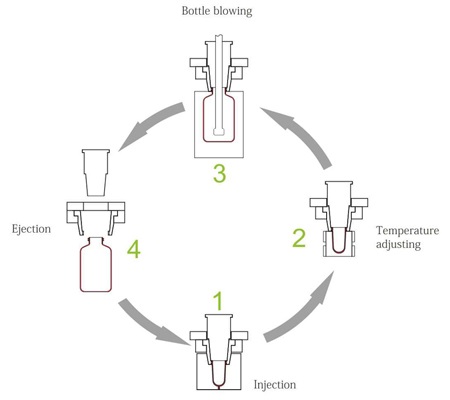Process
There are two major different ways of making a PET bottle or jar: single-stage, or injection stretch blow moulding (ISBM) and two-stage, or re-heat stretch blow moulding (RSBM). We employ both technologies in our company.
In addition, standard injection moulding used to produce plastic closures and other accessories.
Re-heat Stretch Blow Moulding
RSBM is the process of making containers from PET or other resins in two steps. During the first stage, injection machines produce semi-finished products called preforms. At this stage, the neck of the preform is fully finished but the diameter and length is much smaller than the bottle or jar into which it will be transformed. In the second stage of the process, preforms get heated and blown into finished containers.
 (1) preforms are reheated in a IR-oven;
(1) preforms are reheated in a IR-oven;
(2) preform is clamped into the blow mould;
(3) stretch rod goes into and lengthen the softened preform;
(4)-(5) compressed air inflates in two steps to provide better quality of a container’s walls;
(6)-(7) blow mould opens and ready container extracted.
During RSBM transformation, the material undergoes significant changes in molecular orientation enhancing various barrier properties, making PET containers, which are virtually unbreakable, lightweight, and with the perfect clarity that is present in preform.
Injection and blow moulding are completely independent of each other and can therefore be optimized separately. RSBM is very common for mass production, such as bottles for drinks, but it also suits quite well for customized articles and low-scale production thanks to the greater flexibility.
Injection Stretch Blow Moulding
In single-stage production, the entire process from raw material to finished container is conducted within one machine. PET preforms are not produced as intermediate semi-product for later re-heat and blow-molding, but the still-hot injection moulded preform is moved directly into blow-molding section. Blow moulding process is generally the same with re-heat stretch blowmoulding process as described above. 
(1) preform is moulded by injection;
(2) preform is transferred in hot pot station. In some machines this step is skipped;
(3) blowing of a container;
(4) ejection.
The greatest merit of the technology is the reduction in space and product handling, and higher visual quality than can be achieved by the 2-step system. The process core characteristics make it especially suitable for moulding non-standard shapes like off-center containers, oval shapes etc. which is widely used for cosmetics in particular.
Because preforms are moulded from the plastic pelletized material and then stretch-blow molded straight away, not just PET, but a whole range of other plastic materials can be moulded. The single-stage process enables reliable temperature control of plastics with many different characteristics.
Some of those materials are PEN, PE or Tritan, which are used for products like baby bottles because PET cannot withstand the boiling sterilization temperatures that these bottles require.
Both technologies have their advantages and shortcomings. Particular characteristics of a product, projected demand and acceptable level of tooling investments command the choice and we are here to help the right decision-making.